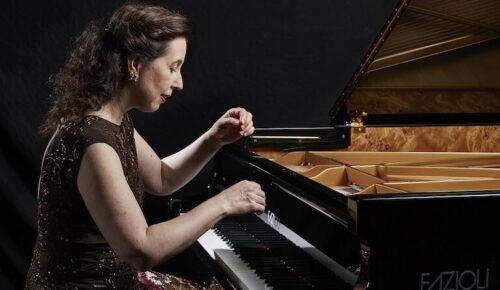 United Kingdom Mozart, Messiaen, and Chopin: Angela Hewitt (piano). Wigmore Hall, London, 23.11.2021. (MB)
United Kingdom Mozart, Messiaen, and Chopin: Angela Hewitt (piano). Wigmore Hall, London, 23.11.2021. (MB)

Mozart – Piano Sonata in C major, KV 309/284b
Messiaen – Préludes: ‘La colombe’, ‘Le nombre léger’, ‘Instants défunts’, ‘Les sons impalpables du rêve’, ‘Plainte calme’, ‘Un reflet dans le vent’
Mozart – Piano Sonata in B-flat major, KV 281/189f
Chopin – Nocturne in F minor Op.55 No.1; Nocturne in E-flat major Op.55 No.2; Scherzo in E major Op.54
A slightly strange programme, this, albeit with much to enjoy. Neither of the Mozart piano sonatas is generally considered popular or even immediately ingratiating; that made it all the more interesting to hear what Angela Hewitt would do with them. Leopold Mozart found the C major Piano Sonata, KV 309/284d ‘strange’, having something in it ‘of the rather artificial Mannheim style’, though he modified that judgement by saying that the Mannheim contingent was ultimately so small that his son’s good style was not spoiled. In the first movement exposition, Hewitt nonetheless seemed to take Leopold at his word, giving an unyielding, unsmiling account, seemingly etched in chrome: clearly a performance decision, since she did not continue like that, either in this or other works. The development’s plunge into the minor was powerfully dramatic, speaking of the opera house both in initial gesture and melting, vocal response. If only there had been greater sense of harmonic direction and indeed of how various figures, finely articulated in themselves, might cohere to form a greater whole. Although neither of the remaining two movements smiled or relaxed quite as they might, they had more of that at least, emerging much the stronger for it. Hewitt’s deadpan sign-off in the finale’s coda was almost worth the price of admission alone.
Hearing six of Messiaen’s eight piano Préludes was a little strange too, though there was plenty of variety to those that reached the stage. In this, the composer’s first published work—Le banquet céleste, written earlier, was published later—we naturally hear considerable influence from Debussy, for which Hewitt’s ability to play ‘without hammers’ proved duly illuminating. There were other ghosts at the feast too: Dukas, Franck, perhaps Ravel, and of course Liszt. It was as fascinating to chart their interaction as to bask in premonitions of Messiaen’s mature musical language and method. Many of the building blocks were there, not least modes of limited transposition, but the sensibility was somewhat different. Sometimes, that is; for in the closing ‘Un reflet dans le vent’, everything—in a wonderfully synthetic vision—came together, both in text and performance. Hewitt seemed to pick up contrapuntal tendencies from Mozart amidst the polymodal chromaticism of ‘Les sons impalpable du rêve’, though Bach was the likelier progenitor. At any rate, there was something feverish enough to suggest a dream world, without loss of clarity or direction. I very much liked the song-like quality imparted to ‘Plainte calme’: a deceptive simplicity, perhaps, in its mysticism. Much the same might be said of the opening prelude, ‘La colombe’, whose constructivism seemed both to the fore and magnificently beside the point.
Hewitt seemed to view—certainly to interpret—Mozart’s B-flat major Sonata, KV 281/189f, more warmly than its predecessor. Here there was just as much variety of articulation as in the C major Sonata, but its first movement seemed to sing more freely. Less Mannheim, perhaps, and more aspiration to Vienna—or even to London, for the spirit of Bach (this time, Johann Christian) is surely more in evidence here. A crisp, unfussy opening Allegro gave way to an Andante amoroso suggestive of opera rather than born of it; this is instrumental music after all. Hewitt’s phrasing and voicing made a fine case for music all too readily underestimated. The closing ‘Rondeau’ delighted, its darker, chromatic turns voiced without over-emphasis, always attentive to a need for light and shade. That is not to suggest an old-fashioned Meissen china sensibility, but rather an ultimately sunny disposition that may not be mine yet has its own rewards. There are, I think, darker currents, sharper dramatic twists here, even in such early Mozart; others are free to think—and play—differently.
Hewitt’s final set turned to Chopin. After a somewhat plain—deliberately so, I am sure—opening to the F minor Nocturne, op.55 no.1, her performance developed into something quite compelling, a strong sense of narrative drive allied to harmonic and motivic development. Likewise for its companion piece in E-flat major, op.55 no.2, which sang as it developed. The E major Scherzo seemed to offer an entire world: not unlike a sonata or symphony, save for the fact that it is entirely unlike a sonata or symphony. Here, rather more so than in Mozart (certainly the C major Sonata), different, contrasting material sounded—and felt—more clearly, dramatically integrated. We hear overt Romantic virtuosity less often than we might from Hewitt, but certainly did at the close: thrillingly. So too did we in a big-hearted, big-boned encore account of Liszt’s transcription of Schumann’s Widmung. I should be fascinated to hear Hewitt play more Liszt.
Mark Berry
